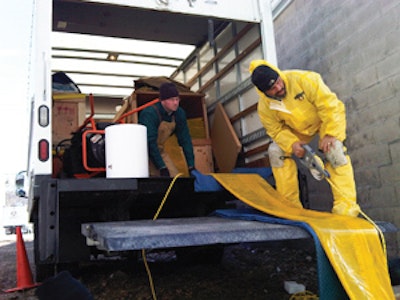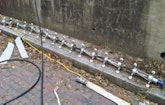
Interested in Relining/Rehab?
Get Relining/Rehab articles, news and videos right in your inbox! Sign up now.
Relining/Rehab + Get AlertsDuring inspection of the Metropolitan Sewer District of Greater Cincinnati (Ohio) combined sewers, workers discovered two sections of 12-inch vitrified clay pipe with collapsing crowns, missing pieces, and joints settled as much as 1.5 inches.
City engineers estimated a cost of $3.4 million to open-cut and replace the 1,196 feet of pipe. To provide the required structural support, felt liners needed walls that were too thick to accommodate flows in the collapsed sections with 9-inch diameters.
After three years of searching for solutions, the city found StreamLinerUV-cured fiberglass reinforced lining systems from LightStream in San Diego, Calif. ASTM D790 test results showed that the liners have a flexural modulus of more than 1.8 million psi and a flexural strength of more than 60,000 psi. The UV-cure process significantly reduced bypass time to lessen the chance of SSOs.
John Flynn III of Flynn Brothers Contracting in Louisville, Ky., won the contract with a $150,000 bid. “I had just become a certified installer and some equipment hadn’t arrived,” he says. “Contractors from California and Georgia arrived with what I needed.” Freezing temperatures, limited access, and municipal regulations slowed progress, but cooperation from all parties enabled completion of the project in seven days.
Bright Alley
The 8- to 23-foot-deep Forest Oak Court line ran under residential buildings and at one point was 11 feet from condominiums. A pickle factory and chrome-plating plant were upstream of the 14-foot-deep Bright Alley sewer that discharged into a 96-inch main. Each line required four liners, manhole to manhole.
Flynn hired SWS Environmental of Cincinnati to clean and inspect the pipe before lining it. With a 7 a.m. temperature around 12 degrees, Tim Clepper, SWS vice president, field supervisor, and safety officer, could not run the Aquatech B10 combination truck (Hi-Vac Corp.) without freezing the lines or damaging the Pratissoli recirculating pumps. City regulations kept him from using the fire hydrants at temperatures below 32 degrees F. Everyone waited until 11 a.m. when the morning warmed up.
“For the first two days, we had no water until noon,” says Flynn. “After the fire marshal granted permission to access the hydrants, I bought a propane torpedo heater and camping tent, erected it over a hydrant, and ran the heater while we drew water.”
Aries inspection equipment recorded a large deposit in the Bright Alley line. The alley was too narrow for the combination truck, so Clepper used an Extendajet easement machine to reach the manhole. “The material appeared to be concrete, but was actually something from the plating factory,” says Flynn. “Tim’s first attempt to remove it polished the face to a bright silver.”
Using a sand and sludge nozzle from Shamrock Pipe Tools and 80 gpm/1,200 psi, Clepper eventually dislodged enough material to satisfy the city.
Alley logistics
LightStream consultants Roy Gallegos and Rene Quitter delivered the eight wetted-out 5-mm liners from the San Diego factory. The liners, wrapped in UV-protective yellow foil and folded in light-proof crates, have a zero to 0.2 percent shrinkage factor.
Avrett Plumbing Co. in Augusta, Ga., sent Emelio Torres and Chris Cogswell with the liner command station and 13-foot-long StreamLinerUV light train on 750 feet of cable. Flynn hired Stefan McKellar from IST Innovative Sewer Technologies in La Jolla, Calif., to reinstate the laterals.
The staging area was an empty lot midway in the alley, which turned 90 degrees and ended at the plating plant’s parking lot. “Our equipment wouldn’t go around the bend to the upstream manhole,” says Flynn. “I spoke to Jim Gentil, the plant’s president, and he let us enter from his side of the street, take down some chain link fencing, and set up in the parking lot.”
During discussions, Flynn learned that the city regulated the plant’s industrial wastewater discharge – 3,000 to 4,000 gallons daily between 1 and 3 p.m. The volume would overwhelm his rented 4-inch diesel trailer-mounted self-priming bypass pump. Mike Stevens, with MSD Greater Cincinnati, worked with district and plant officials to change the discharge times.
Air and light
Liners were cut to length. The longest run was 230 feet. To install them, workers laid a roller assembly over a manhole, then laid the liner on 2-mm white sliding foil to protect it and facilitate its passage.
They folded the liner in half lengthwise to fit the width over the roller, then folded the nose back over a nylon choker with a cable attached. After securing the nose with two nylon straps, five crew members passed the liner by hand from the truck to a manhole, where it was pulled in by a shop-built 3-ton winch powered by a lawn mower engine.
In a confined-space-entry procedure, a worker at the bottom of the manhole made sure that the pulling cable was level and aligned with the pipe so as not to damage the liner. When it reached the downstream manhole, the crew freed it, but left enough material to slip over cylindrical cans called gate valves, one in each end of the liner. They were duct taped, then winched down with a ratchet strap for an airtight seal.
“I inflated the liner to 8 psi from the command station,” says Cogswell. “Roy then removed the upstream can to insert the light train and reattached the can, and I pressurized the liner again.”
As Gallegos pulled a rope attached to the light source, a camera on each end of it enabled Cogswell to inspect the liner for imperfections and fit. “If something were wrong, we could collapse the liner and fix the problem,” he says. The cameras found no imperfections.
Communicating by two-way radio, Cogswell told Gallegos when to stop pulling as the light source reached the end of the liner. After setting certain fields in the operating program, he ignited the eight 400-watt UV lights and the computer controlled the speed of the cable reel, which pulled the lights upstream as they cured the resin.
Acceptance
The most difficult run in Bright Alley was also one of the shortest – 136 feet. The junction where the 12-inch line tied into the 96-inch main had no manhole, and access to the main was almost 8 feet downstream. “We set the winch at that manhole, then mounted a pulley at the bottom to guide the cable,” says Flynn. “Another pulley mounted on the pipe wall opposite the junction ran the cable straight into the 12-inch line.” The setup was flawless and the lining process went smoothly.
Before lining began at Forest Oak Court, Flynn’s crew distributed flyers explaining what would happen and asking residents not to wash clothes or take showers during work hours. “They all cooperated, and went out of their way not to park around our equipment,” says Flynn.
“One day, we pulled in three liners between 8 a.m. and 3:30 a.m. We had some mechanical trouble, and Stefan ended up reinstating laterals at two in the morning. They were very understanding of the terrible noise. Only one lady poked her head out the window to ask how long we’d be.”







